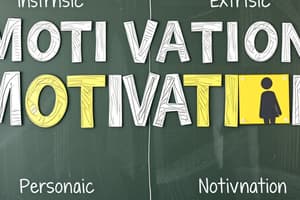Podcast
Questions and Answers
What do values primarily guide in an individual's behavior?
What do values primarily guide in an individual's behavior?
- Choices made to fulfill specific needs (correct)
- Emotional reactions to situations
- Spontaneous decision-making processes
- Satisfaction of all needs
Which of the following personality types is associated with being cautious and reliable?
Which of the following personality types is associated with being cautious and reliable?
- Reserved, quiet, introverted (correct)
- Social, outgoing, extroverted
- Assertive, in control, decisive
- Spontaneous, creative, impulsive
According to the information, which statement is true regarding the relationship between talent and motivation?
According to the information, which statement is true regarding the relationship between talent and motivation?
- Talented individuals prefer simpler tasks to maximize success
- High ability guarantees higher performance in all cases
- A nurturing environment is essential for utilizing one's talents effectively (correct)
- All talented individuals are motivated to perform at high levels
What is one of the personality traits identified as being creative and impulsive?
What is one of the personality traits identified as being creative and impulsive?
What is generally true about individuals with high levels of ability?
What is generally true about individuals with high levels of ability?
What is necessary for performance to be affected by monetary incentives and feedback?
What is necessary for performance to be affected by monetary incentives and feedback?
According to expectancy theory, what does instrumentality refer to?
According to expectancy theory, what does instrumentality refer to?
What does equity theory emphasize regarding employee motivation?
What does equity theory emphasize regarding employee motivation?
What is the primary outcome of the law of effect in behavior modification?
What is the primary outcome of the law of effect in behavior modification?
Which concept refers to the degree of satisfaction anticipated from an outcome in expectancy theory?
Which concept refers to the degree of satisfaction anticipated from an outcome in expectancy theory?
How should goals be set to ensure they are effective?
How should goals be set to ensure they are effective?
What does the job sculpting approach emphasize in motivation?
What does the job sculpting approach emphasize in motivation?
What does expectancy reflect in the context of expectancy theory?
What does expectancy reflect in the context of expectancy theory?
What characterizes specific goals in terms of performance outcomes?
What characterizes specific goals in terms of performance outcomes?
Which layer of Maslow's hierarchy of needs addresses the desire for love and affection?
Which layer of Maslow's hierarchy of needs addresses the desire for love and affection?
According to Herzberg's two-factor theory, which of the following is categorized as hygiene factors?
According to Herzberg's two-factor theory, which of the following is categorized as hygiene factors?
What is the primary focus of McClelland’s needs theory?
What is the primary focus of McClelland’s needs theory?
What is meant by 'goal-setting theory' in the context of motivation?
What is meant by 'goal-setting theory' in the context of motivation?
In Alderfer’s ERG theory, which need involves relationships and sharing feelings?
In Alderfer’s ERG theory, which need involves relationships and sharing feelings?
Which approach emphasizes the importance of experiencing meaningful work as a motivator?
Which approach emphasizes the importance of experiencing meaningful work as a motivator?
How does the need for power (nPow) manifest according to McClelland’s needs theory?
How does the need for power (nPow) manifest according to McClelland’s needs theory?
What do the higher-order needs in Maslow's hierarchy pertain to?
What do the higher-order needs in Maslow's hierarchy pertain to?
Which of the following is NOT a characteristic of job characteristics that influence motivation?
Which of the following is NOT a characteristic of job characteristics that influence motivation?
What does self-efficacy primarily relate to?
What does self-efficacy primarily relate to?
Which proposition of cognitive evaluation theory suggests that perceived control influences motivation?
Which proposition of cognitive evaluation theory suggests that perceived control influences motivation?
How do McGregor's Theory X managers typically view their employees?
How do McGregor's Theory X managers typically view their employees?
What is a self-fulfilling prophecy in the context of management?
What is a self-fulfilling prophecy in the context of management?
Which of the following enhances intrinsic motivation according to cognitive evaluation theory?
Which of the following enhances intrinsic motivation according to cognitive evaluation theory?
What aspect of behavior does self-efficacy NOT concern?
What aspect of behavior does self-efficacy NOT concern?
Which statement most accurately reflects the perspective of Theory Y managers?
Which statement most accurately reflects the perspective of Theory Y managers?
What undermines intrinsic motivation according to cognitive evaluation theory?
What undermines intrinsic motivation according to cognitive evaluation theory?
What is the primary characteristic of motivation as described in workplace contexts?
What is the primary characteristic of motivation as described in workplace contexts?
What is the primary distinction between extrinsic and intrinsic motivation?
What is the primary distinction between extrinsic and intrinsic motivation?
Which of the following best describes the impact of culture on motivation?
Which of the following best describes the impact of culture on motivation?
How does emotion influence motivation according to the concepts mentioned?
How does emotion influence motivation according to the concepts mentioned?
What role does the concept of flow play in motivation?
What role does the concept of flow play in motivation?
Which statement about the relationship between motivation and behaviour is true?
Which statement about the relationship between motivation and behaviour is true?
What is a key factor for management in the context of motivating employees?
What is a key factor for management in the context of motivating employees?
What is a characteristic of physiological needs according to the homeostatic drive theory?
What is a characteristic of physiological needs according to the homeostatic drive theory?
What type of motivation is characterized by behaviors that are a reward in themselves?
What type of motivation is characterized by behaviors that are a reward in themselves?
What is the primary focus of I-O psychology in relation to motivation?
What is the primary focus of I-O psychology in relation to motivation?
In which way do personality differences and values affect motivation?
In which way do personality differences and values affect motivation?
What is a significant characteristic of motivation as discussed in workplace contexts?
What is a significant characteristic of motivation as discussed in workplace contexts?
How do diverse cultural factors impact workplace motivation?
How do diverse cultural factors impact workplace motivation?
What does the engagement concept emphasize in a workplace context?
What does the engagement concept emphasize in a workplace context?
Flashcards are hidden until you start studying
Study Notes
Motivation and Emotion
- Motivation is the internal drive that initiates goal-directed behaviors. It is the push or pull that guides our actions.
- Emotion plays a critical role in motivation by influencing:
- The strength of motivation.
- The appraisal process that leads to action.
- The choice of behavior and its intensity.
- It is intricately linked to motivation and often complements it.
Extrinsic vs. Intrinsic Motivation
- Extrinsic motivation is driven by external factors, like rewards, punishments, or circumstances.
- Intrinsic motivation stems from internal drivers like satisfaction, accomplishment, and a sense of meaning in the work itself.
Internal Motivational Concepts
- Flow: A state of complete absorption and enjoyment in work, leading to optimal performance and engagement.
- Engagement: A feeling of passionate involvement in one's work, leading to greater commitment and productivity.
Theories of Motivation
- Homeostatic drive theory: This theory explains how our bodies maintain equilibrium by regulating physiological needs like hunger, thirst, and temperature.
- Herzberg’s two-factor theory: Identifies two types of factors influencing job satisfaction:
- Hygiene factors: Related to the work environment (salary, safety, job security) and prevent dissatisfaction.
- Motivators: Related to the content of the job (achievement, recognition, responsibility) and lead to satisfaction.
- Job Design: Enhancing job characteristics to increase intrinsic motivation and job satisfaction through:
- Job rotation
- Job enlargement
- Job enrichment
- Job crafting
- Maslow's Hierarchy of Needs: This theory outlines a hierarchy of needs, starting from basic physiological needs and progressing to self-actualization. Lower-order needs must be met before higher-order needs become motivators.
- Alderfer's ERG Theory: Similar to Maslow, but groups needs into three categories:
- Existence: Basic needs for survival.
- Relatedness: Needs for social bonds and connection.
- Growth: Needs for self-actualization and development.
- McClelland's Needs Theory: Focuses on three needs:
- Achievement: The desire to excel and succeed.
- Power: The desire to influence and control others.
- Affiliation: The desire for belonging and social connection.
- Goal-setting theory: Argues that specific, challenging goals, when accepted and committed to, lead to higher performance than vague or absent goals.
- Behavior modification: Based on the law of effect, it states that behaviors followed by positive consequences are more likely to be repeated.
- Expectancy theory: Motivation is influenced by the individual's belief in:
- Valence: How much they value the outcome.
- Instrumentality: Whether their actions will lead to the desired outcome.
- Expectancy: Whether they can achieve the goal with their effort.
- Equity theory: Individuals compare their inputs and outputs to others in similar situations, leading to motivation when they perceive fairness in the exchange.
- Self-efficacy theory: People's belief in their ability to succeed influences their motivation and performance.
- Cognitive evaluation theory: This theory focuses on the psychological meaning assigned to events in relation to intrinsic motivation.
- McGregor's Theory X and Theory Y: Two contrasting sets of assumptions about workers:
- Theory X: Assumes employees are lazy and require close supervision.
- Theory Y: Assumes employees are motivated and self-directed.
- Self-fulfilling prophecy: Managers' expectations about employees can become reality, influencing their behavior and performance.
Impact of Culture
- Different cultures have different values and norms that influence how people perceive work and motivation.
- It is crucial to understand the cultural context of employees to tailor motivation strategies effectively.
Studying That Suits You
Use AI to generate personalized quizzes and flashcards to suit your learning preferences.



